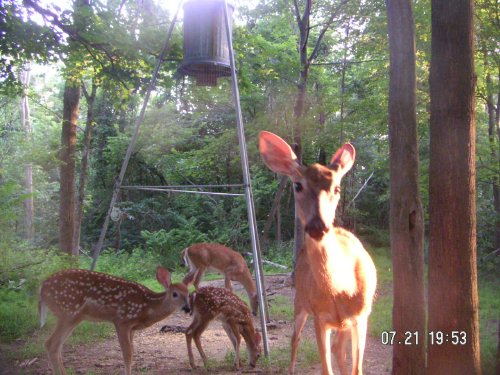|
Penns Woods Digital ScoutYou might be wondering why I chose the cheaper model of the two available from Penns Woods. For one reason it was the cheaper one and it fit into my budget at the time. The other reason is that the newest Penns Woods Digital Scout has a Sony 4.1 camera in it. This is the very same camera that is in the EagleEye that I have already reviewed. I knew that this was a good camera. Since the Penns Woods Digital Scouts all use the same electronics I could test the electronics in the cheaper model and determine what their models operate like. I was also a little curious how the 2.0 megapixel camera would compare to the 4.1 megapixel camera. As usual I did the preliminary testing in our living room to familiarize myself with the unit and get a quick idea on power up time. In this short test the digital scout was relatively easy to set up and the power up time seemed a little longer than some. In the first couple of months I took over 300 pictures with the Penns Woods Digital Scout. I did make one mistake. I learned that after doing the walk test you need to change the switches back to the correct mode and turn the unit off and back on. Needless to say, I forgot to turn it back on. Sometimes I learn things the hard way. I no longer use the test mode, I just set the digital scout up and wait around to make sure it takes my picture. The picture quality is better than the cheaper cameras and just a little poorer than the 4.1 megapixel camera. The color is real good and the quality is equally good at any time of the day. The factor that sets the Soney 4.1 above the 2.0 is the picture quality when it is dark. Pictures taken in complete darkness start to get grainy with the 2.0. Pictures stay crystal clear with the 4.1 megapixel camera. You can take this link to see examples of the picture quality along with further explanation. This deer scouting camera operates on two AA batteries and the electronics use 4 AA batteries. I use rechargeable batteries and everything works just fine. Every time I retrieve the camera I re-charge the batteries and put it right back out. I've not had these batteries go dead in the camera unit. Set-up and operation of the Penns Woods Digital Scout has been relatively easy. The electronics use dipswitch controls and there is a toggle switch for on/off operation. The dipswitch setting instructions printed inside of the case are very convenient. Since the unit contains a real honest to goodness digital camera you do have to get the settings right on the camera. This did not prove to be real difficult but you do have to crack open the instruction manual. Once you get the camera set up you will likely never change it again. I tested the power up time against the EagleEye and the Leaf River by setting the three cameras side by side in a dark room. The three cameras were each about one second apart. The EagleEye flashed first, the Penns Woods second and the Leaf River last. There was about a second between each camera. I think that the reason that the Penns Woods is a little slower than the EagleEye is that the Minolta camera does not have a viewfinder thus you can’t turn off the TFT display. When you use the Sony 4.1 you turn the TFT display off to quicken the power up time. In June, I forgot to turn the display off on the EagleEye and noticed that the power up time was slower and that the batteries were almost dead. The display screen definitely has an effect. The Digital Scout comes with a Master Lock Python cable locking system to attach it to and lock it to the tree. I really like these locking cables. The eyes for attaching the unit to a tree are placed on the case so that you can open the case while it is attached to the tree if you want to. The unit comes with an 8 MB SD card. This is a little slim on memory so I purchase a 256 MB SD card to use. The 8 MB card wouldn’t hold many pictures and wouldn't be of much use unless you could check your camera frequently. As previously mentioned the Minolta camera has a TFT display so that you can view your pictures right in the field. I really like this capability and usually take a look at the pictures as soon as I get to the camera. It also comes with a USB cable to download the pictures directly to a computer. The Digital Scout has eight different time delays ranging from 10 seconds to 20 minutes. These delays are sufficient for getting plenty of pictures whether you put it at a feeder or along a trail. The Minolta camera can be removed and used as a separate personal use digital camera. This is not a big issue, but since the cost of this unit is rather high you could use it as both a personal camera and a scouting camera. The camera has the capability of taking 15 second video clips. The Penns Woods Digital Scout is a real nice scouting camera and became one of my dependable workhorses. After 18 months and somewhere in the neighborhood of 10,000 pictures taken the Minolta camera quit working. Since then we purchased another Minolta camera and replaced the one in the unit. After about two months this Minolta camera quit working properly as well. For now we have quit using this trail camera.

|
